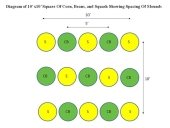















much of what my neighbours consider to be good I consider to be bad
 1
1








"You may never know what results come of your action, but if you do nothing there will be no result”
How Permies.com Works
Be Nice





 )
)
 I just put everything in at the same time, which is apparently traditional, but I didn't plant on mounds, which is not at all traditional! It's a very small area, prone to drying out and I avoid going up if possible. I put seed straight into the (very amended) soil, corn about a foot apart with beans close.
I just put everything in at the same time, which is apparently traditional, but I didn't plant on mounds, which is not at all traditional! It's a very small area, prone to drying out and I avoid going up if possible. I put seed straight into the (very amended) soil, corn about a foot apart with beans close.








1. my projects














much of what my neighbours consider to be good I consider to be bad

|
She laughed at how small it was, and now it is even smaller. Poor tiny ad:
The new purple deck of permaculture playing cards
https://www.kickstarter.com/projects/paulwheaton/garden-cards
|



